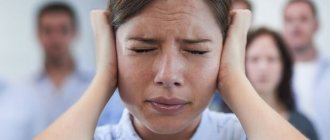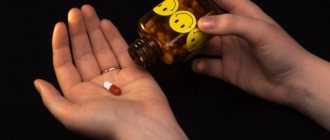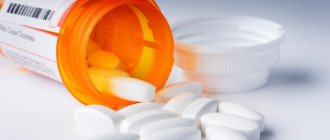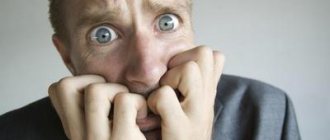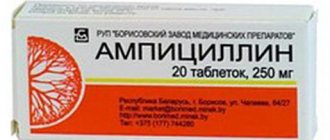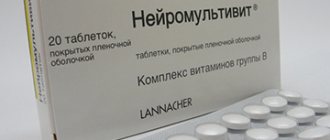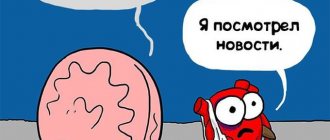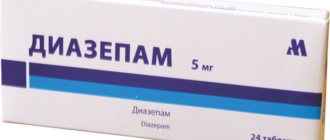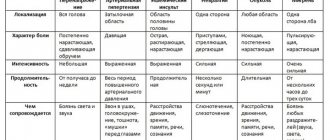The issue of treating panic attacks is extremely important, since these attacks seriously impair the quality of life of people and negatively affect their health. As a rule, both medication and psychotherapeutic techniques are used. All this should be discussed in more detail.
Panic attacks seriously impair a person's quality of life
More
If you do not have generalized anxiety disorder and panic attacks, your anxiety arises only in stressful situations (exam, performance, important event), it is still better to visit a good psychiatrist or psychotherapist and discuss the correction option with him.
Sometimes the problem turns out to be deeper than originally thought. Medications can include tranquilizers and beta blockers. The use of tranquilizers is limited by side effects, and beta blockers have a weak evidence base.
If valerian and similar drugs help you, you can consider them your personal placebo. Often these drugs are effective in particularly suggestible patients. In addition, the alcohol contained in the tincture helps. Do you need alcohol before an exam? So psychotherapy is a good option for solving the problem.
Source: yandex.ru
How to recognize a panic attack
A panic attack can occur in a practically healthy person if, for example, he finds himself in a situation with a real threat to his life. But more often the cause of PA is deviations in the state of human health - somatic, psychophysiological, mental. A panic attack is a companion to neurosis, vegetative-vascular dystonia, pathological fears and phobias. Diseases of the heart, blood vessels, endocrine disorders, trauma and brain tumors are also factors that provoke attacks.
Important! Panic attacks have symptoms similar to a hypertensive crisis or heart attack. A clear understanding of the signs of PA will help to recognize it against the background of signs of a dangerous attack of serious organic pathology.
How an attack begins and goes away:
- A panic attack is preceded by severe anxiety and a feeling of discomfort. The heartbeat quickens, blood pressure may rise and you may feel dizzy, limbs become weaker, and trembling appears. Breathing becomes difficult and you may feel faint. Against the background of these incomprehensible frightening manifestations, fear intensifies and turns into horror, which is accompanied by an acute feeling of approaching death.
- As programmed by nature, under the influence of sudden fear the body is mobilized, the adrenal glands are activated, and hormones are released into the blood. and cause increased breathing and heart contractions, increased blood pressure, accelerate metabolism and increase muscle tone. The purpose of these physiological changes is to overcome stress and cope with danger. But in the case of a panic attack, there is no real danger, the subconscious search for the cause of such a reaction ends in failure, and vegetative reactions arise. Anxiety and fear increase and contribute to additional hormone release. In a matter of minutes the circle closes.
Either the person himself can open this circle and stop the panic attack by trying to overcome anxiety or distract himself from it. Or the supply of hormones will be depleted, and the panic attack will end on its own, as unexpectedly as it began. In this case, medication for panic attacks is not required.
First aid in case of attack
As a rule, a person is able to cope with a panic attack on his own, without calling an ambulance. You need to provide a flow of fresh air, for example, open a window or just go outside. You can wash your face with cold water and take medicine for panic attacks. You need to move, breathe correctly.
During a panic attack, breathing usually becomes shallow and frequent, so it is good to change it to deep, slow, diaphragmatic inhalations and exhalations. The method of increasing the concentration of carbon dioxide in the lungs by breathing into a paper bag or at least into palms folded into a hemisphere helps greatly. The main thing is that you need to switch your thoughts from anxiety to positivity and calm at all costs. Remember something very good from your life, rewatch your favorite comedy, call a loved one and distract yourself by talking about something pleasant. Finally, there are many specific exercises for overcoming anxiety.
Anyone who is nearby at the time of a panic attack can also help reduce or stop the attack. In no case should you separate fear and panic, although the sight of someone else’s panic attack does not cause joy at all, but precisely these feelings. You need to gather all your confidence and convince the patient that nothing terrible is happening, everything will end quickly and safely. Hold a person's hand, offer medicine for panic attacks. And only if the panic attack drags on, despite all the efforts of the person himself and outside help, the condition looks threatening, then it is worth calling an ambulance. Specialists will be able to provide assistance with more effective medications for panic attacks in a crisis situation.
Treatment methods
The earlier treatment for this disorder is started, the easier it is to achieve a positive result. The main ways to get rid of the disease:
- Drug therapy.
- Psychotherapy.
- A person’s independent work to change their lifestyle and attitude towards life circumstances.
Medicines for panic attacks are good primarily because they act quickly. A panic attack can be relieved in just minutes.
Some of them are of plant origin and are affordable to anyone. An important factor is ease of use. Is it possible to compare quickly taking a pill with long-term work to find out the root causes of panic attacks, resolve your internal conflicts, master special exercises, breathing and meditative practices? But the time factor in this case does not always play on the patient’s side. The side effects and contraindications of many medications have not been canceled. Therefore, if the disease is in its early stages, you can do without taking medications.
Psychotherapeutic treatment can occur either in combination with drug therapy or independently, depending on the severity of the disorder. With the help of a psychotherapist, the patient searches for and explores the causes of anxiety and panic, and uses various techniques to combat the symptoms. Cognitive behavioral psychotherapy teaches a person to develop patterns of behavior in anxious and stressful situations. Nowadays, you can even learn more about the possibilities of psychotherapy in treating this illness online. In particular, Nikita Valeryevich Baturin, a psychologist with many years of experience, has accumulated extensive experience in overcoming such conditions.
We recommend watching the video on how to relieve a panic attack or find a method of self-prevention:
Sedatives
- Grandaxin. Does not cause drowsiness. It is worth considering the possible negative consequences of an overdose, namely rash, dyspeptic disorders, overexcitement. Contraindications include withdrawal syndrome, early pregnancy (first three months), manic disorder.
- Phenibut. It is also a tranquilizer. Helps relieve panic attacks, reduce anxiety, and balances the psycho-emotional state. Causes drowsiness.
- Corvalol. Helps relieve tachycardia, eliminates insomnia and minor hypertension. Causes drowsiness.
- Valerian infusion. Stops minor tachycardia, relieves insomnia, and alleviates panic attacks. Side effects include changes in stool and inhibition of reactions. Fructose intolerance and lactase deficiency are the main contraindications.
- Valocordin helps with neuroses, insomnia, tachycardia. Take 15, maximum 25 drops before meals if there is a rapid heartbeat. This drug has the main side effect, the development of dependence on the drug, and withdrawal syndrome occurs when you refuse it. Contraindications are kidney disease, porphyria.
- Validol. Also a sedative. It has a calming effect in cases of increased anxiety and instability of emotions. It is possible that nausea and dizziness may occur in extremely rare cases.
- Persen. Prevents emotional arousal, relieves insomnia and panic attacks. With prolonged use, constipation occurs. Contraindicated in children under three years of age.
Medicines for the treatment of PA
Drug treatment of panic attacks involves individual selection of medications for each patient. The choice of drug for panic attacks is usually made based on five general groups:
- Sedatives.
- Anxiolytics.
- Antidepressants.
- Neuroleptic drugs.
- Nootropics.
Important! Pills for panic attacks and fear are prescribed and controlled by a doctor only!
For your peace of mind (and peace of mind is practically the main condition for defeating panic attacks), it is good to understand what medications for panic attacks and phobias can be prescribed by a doctor. Awareness in this case will not be superfluous.
Sedatives
Sedatives are perhaps the first thing people start drinking during panic attacks, often on their own. In the early stages, these are indeed the most used remedies. Most often they are made from plant materials or are based on bromine. To produce sedative medications for panic attacks, natural ingredients such as valerian, motherwort, mint, St. John's wort, lily of the valley, passionflower, and peony are used. Among the sedative drugs, the usual Valerian, Corvalol, Valocordin, Validol, Persen, Novo-passit are widely known.
Since the concentrations of active ingredients in sedative medications are low, a prescription to purchase them from a pharmacy is not required, and you can treat panic attacks with some sedative medications yourself.
These drugs are good at reducing anxiety and irritability, promoting sleep, and have a moderate effect on the heart, reducing rapid heartbeat.
This is interesting! Alcohol tinctures of plants with a sedative effect act quickly, within 5–30 minutes. Tablets have a slower effect, but have a cumulative effect, so they are prescribed for course use.
Tranquilizers
Tranquilizers (also known as anxiolytics) are a synthetic remedy for panic attacks. They have the following effects:
- anxiolytic (anti-anxiety);
- sedative;
- anticonvulsant;
- hypnotic;
- vegetative stabilizing;
- antiphobic;
- muscle relaxant.
Important! When taken, tranquilizers quickly cause an addictive effect.
Due to addiction, the course of administration should not exceed two weeks; a doctor’s prescription is required for purchase. Depending on the active substance, anxiolytics are divided into four main groups:
- Benzodiazepines, some of them are Noosepam, Phenazepam, Diazepam.
- Diphenylamine: Atarax, Amizil and others.
- Carbamine esters - Meprobamate.
- Derivatives of other chemical groups, including Afobazole, Spitomin, Buspirone, etc.
Tranquilizers are also divided by duration of action; there are three types. Short-acting agents retain their therapeutic effect for up to 6 hours, medium-acting for 24 hours, long-acting for up to 48 hours. Today, three generations of drugs for panic attacks from the anxiolytic group are available.
Antidepressants
Antidepressants for panic attacks are used because regular panic attacks and continuous anxious anticipation of waves of panic can cause signs of depression. The neural network of the brain is exposed to the active substance, and its normal functioning is restored. These drugs also help restore emotional stability, reduce excitability, tension, general anxiety, improve a person’s overall mood, and prevent panic attacks.
When treating panic attacks with antidepressants, the dosage prescribed by the doctor is small at first, gradually increases, and then decreases again until the drug is completely discontinued. The duration of admission is long, from six months to a year. The advantage of these medications is that they are not addictive, but there are many disadvantages. Dizziness and headache, dyspeptic disorders, lethargy, feeling of weakness and drowsiness, insomnia.
Today, the fourth generation of antidepressants is available: Milnacipran, Remeron, Wellbutrin, Plizil. They have less side effects and high speed of action. However, proven products from the first two generations remain popular because they are more affordable. These are Amitriptyline, Clomipramine, Fluoxetine, Venlafaxine.
Neuroleptics
Second generation antipsychotic drugs are used to treat panic attacks. They are usually an adjunctive therapy rather than a primary medication. Neuroleptics are a kind of sedative, they reduce reactions to external stimuli, relieve psychomotor agitation and affective tension, suppress fear, and help relieve aggressiveness. These are the drugs Sonapax, Melleril, Thiokril, Truxal.
When treated with them, the reticular formation of the brain, which is involved in the control of many body functions, is inhibited, and its activating effect on the cerebral cortex is weakened. They do not have a hypnotic effect. Long-term use can lead to tremor of the hands and disturbances in the endocrine system.
Nootropic drugs
These panic attack medications are usually prescribed in combination with other anxiety medications. They regulate the activity of the central nervous system, improve brain function, memory, and attention. The peculiarity of these drugs is their ability to increase the body’s adaptive capabilities, the ability to withstand stress and cope with heavy physical and mental stress, and with fear. The most famous of the nootropics is Glycine.
Nootropic drug Phenibut
If PAs recur regularly, then this is a good reason to consult a doctor and determine the source of the pathology. Treatment with medications can only be carried out as prescribed by a doctor. To relieve panic attacks, drugs from various pharmacological groups are used.
Sedative (psycholeptic) drugs
Preparations of plant or artificial origin. They have a mild sedative effect. They calm the nervous system well, activating inhibition processes in the brain. Relieves cardiac arousal, eliminates the stress factor of deteriorating breathing. The drugs do not have a hypnotic effect, but due to their calming effect on the nervous system, they have a beneficial effect on falling asleep and quality of sleep.
In addition, sedative drugs are well tolerated, are safe, have minimal side effects, and do not cause addiction. Such medications are not used as the main means of therapy, since their effect is not strong enough. LS: Valocordin, Corvalol, tinctures of peony, eleutherococcus, Syncapton, etc.
Anxiolytics (tranquilizers)
They help with anxious depression, relieving increased anxiety, fear, and normalizing the psycho-emotional state and functioning of the cardiovascular system. For PA they can be used one-time - as an ambulance and as a course. They cause addiction, so treatment should not be long-term. The dosage and method of using medications are determined on an individual basis.
For immediate relief of an attack of severe fear, special fast-acting anti-panic drugs - medications of the benzodiazepine group - are well suited. The effect after administration appears very quickly - 10-15 minutes after taking the tablets or injections. Phenazepam is considered one of the best for panic attacks.
The disadvantage of tranquilizers is their ability to inhibit reactions, reduce attentiveness, and psychomotor activity. Medicines for PA: Alprazolam, Atarax, Afobazol, Spitomin, Phenazepam, Diazepam, Dormicum.
Neuroleptics
The main purpose of antipsychotics is the treatment of severe psychoses of psychoorganic etiology, neuroses and disorders that are accompanied by complex disorders in the form of hallucinations, delusions, fear, etc. Use in PA is indicated as an additional remedy: the drug helps reduce the intensity of the patient’s reaction to a stimulus, suppress aggressiveness, stop affect.
Nootropic drugs
They have a sedative effect. They are prescribed for PA to improve the cognitive functions of the brain, increase the resistance of cells in extreme and stressful conditions, which contributes to better adaptation to the situation and decision-making. Helps you better cope with sudden fear. Used as an adjuvant to the main treatment. The drugs are characterized by low toxicity, a sedative effect without a hypnotic effect, and a minimal number of side effects. LS: Semax.
Antidepressants
They are used for PA due to their ability to relieve anxiety, restlessness, and normalize the mental state. Since these drugs have a narrow focus of action, when prescribing, an accurate determination of the dosage and its compliance is required. The drugs are not addictive. Drugs: Stimuloton, Escitalopram,
In addition to these main groups, medications from other groups are also used to prevent PA, for example, Glycine. The drug is a metabolic agent that improves the functioning and stability of GM cells. The prescription of Glycine for panic attacks is indicated in the course, since the drug normalizes inhibition processes in the central nervous system, relieves internal tension, and increases the psycho-emotional stability of the body in stressful situations. Thus, the drug relieves the causes of anxiety attacks.
Each drug has its own characteristics in purpose, effect, compatibility and side effects. Therefore, only a doctor can determine which will help better in a particular case - Afobazol, Eleutherococcus or Atarax.
The medicine "Phenibut" is prescribed for the treatment of panic attacks in order to normalize mental activity and cerebral circulation. In addition, the drug has a calming and anti-anxiety effect.
Phenibut helps normalize sleep, get rid of nervous tension and emotional instability. Indications for use of the drug are panic attacks, phobias and asthenia.
"Phenibut" quickly improves the patient's well-being, increasing memory and improving the patient's sensory-motor reactions.
The medicine is non-toxic and is well absorbed by the body. The likelihood of an allergic reaction and the development of side effects when taking the drug is minimal, provided there is no individual intolerance to the active substance. The course of treatment and dosage of Phenibut are selected only by the attending physician. Possible side effects:
- fluctuations in blood pressure;
- drowsiness;
- fast fatiguability;
- digestive disorders;
- nausea.
The entire list of possible side effects is described in the instructions. If Phenibut has been taken for a long time, the dosage should be gradually reduced. Abrupt cessation of taking the drug can provoke the development of withdrawal syndrome and the return of symptoms of vegetative-vascular dystonia and panic attacks. The drug is contraindicated during pregnancy and lactation.
How to stop a panic attack?
During periods of temporary improvement in well-being, many patients go through the contents of the first aid kit, doubting whether they have purchased the right set of products.
You should know: there are no magic cures, especially considering the characteristics of each individual organism. And every VSD sufferer experiences panic attacks differently: some are able to heroically withstand the adrenaline rush without any medications, while others need a whole range of tablets, capsules and sedative drops.
There are several types of medications for panic attacks: herbal (mild), herbal with the addition of chemicals, and only chemical ones, which cannot be obtained without a prescription. Each category has its pros and cons. It is best to entrust the choice of remedy to a doctor; self-medication can aggravate the problems.
Atarax
The drug Atarax belongs to the group of anxiolytics, it is prescribed for the treatment of neuroses and chronic allergic diseases. This drug is well tolerated by patients and has few side effects and contraindications.
Atarax is able to have a relaxing effect on skeletal and smooth (internal) muscles, which leads to the relief of spasms and can provide relief during panic attacks.
Atarax does not depress the central nervous system, but can depress certain zones of the subcortical region. The main active ingredient is hydroxyzine dihydrochloride, a derivative of diphenylmethane. Atarax has a bronchodilator and antihistamine effect; in normal doses it does not affect the functions of the stomach. Atarax is also effective in the treatment of urticaria and eczema, itching in various allergic dermatitis, and increases the total duration of sleep. Atarax does not cause memory impairment. It is quickly absorbed in the gastrointestinal tract and enters the blood.
Atarax is used to treat symptoms of anxiety, including panic attacks, and symptomatic treatment of itching. Tablets of the drug are taken orally. For anxiety conditions, it is recommended to take 0.05 g per day.
The side effects that atarax promotes are as follows:
- increased fatigue, general weakness, increased body temperature;
- decreased blood pressure, headache;
- dry mouth, sometimes nausea, vomiting, constipation;
- transient decrease in vision clarity;
The drug atarax has the following contraindications: hypersensitivity to the components of the drug, hereditary galactose intolerance, porphyria. Atarax is contraindicated during pregnancy and breastfeeding. Atarax enhances its effect when taking alcohol, reduces the effect of epinephrine and phenytoin.
The result of an overdose of the drug Atarax manifests itself in the form of nausea, vomiting, depression or stimulation of the central nervous system, hallucinations, and arrhythmia.
Another effective tranquilizer is the medicine Atarax. It promotes:
- reducing anxiety;
- relieving muscle spasms;
- normalization of the nervous system;
- reducing skin manifestations of allergic reactions.
Features of the drug "Atarax" are its good tolerability. The drug does not depress the activity of the central nervous system and does not cause drowsiness.
With the correct dosage, the likelihood of side effects is minimal. In some cases, the following conditions may occur:
- weakness;
- nausea;
- decreased vision sharpness;
- decreased blood pressure;
- headache.
In case of an overdose of the drug, hallucinations, tachycardia and arrhythmia, difficulty breathing and symptoms of poisoning are observed. The drug is not prescribed to pregnant women and nursing mothers, as well as to patients with galactose intolerance.
Panic attack medications without a prescription
This category of drugs attracts the largest number of patients. Many people mistakenly believe that “over-the-counter” pills are not always effective, but are completely safe, so you can increase the dosage yourself - nothing will happen.
But it's not that simple. Even an overdose of ordinary water can be fatal, but what about medications?
Pros: average price category, accessibility, relative safety, first aid in critical stressful situations.
Disadvantages: lack of a treatment regimen, thoughtless dosage, impact not on the source of the problem, but on suppressing its individual manifestations.
The most popular medications for panic attacks that can be purchased without a prescription:
- Glycine. This is the easiest and cheapest drug, which is often prescribed even to teenagers at the end of the school year, associated with nervous overload. Suitable for patients whose panic attacks do not reach the point of “help, I’m dying.” To stop an attack, large dosages of 600 mg or more are needed.
- Anaprilin. The most “favorite” drug of alarmists. Effective, but extremely dangerous. It is surprising that it is generally sold without a doctor’s prescription to anyone who wants it. A tablet placed under the tongue literally forcibly stabilizes blood pressure and heart rate. An overdose can end badly, and too frequent use causes the body to become addicted and worsen the symptoms of a panic attack.
- Afobazol. A sedative that activates special proteins inside the cells of the nervous system, due to which its “repair” occurs. The good thing about the tablets is that they do not cause addiction or side effects (in most cases), and do not inhibit the patient’s thought processes and attention. But you need to undergo a course of treatment before the effect of the drug makes itself felt in a useful way. Suitable for relieving mild panic attacks.
- Valocordin (Corvalol). Phenobarbital-based drops help relieve the critical and frightening symptoms of a panic attack. The medicine inhibits the activity of the brain and nervous system, relaxes muscles, causes a feeling of drowsiness, and even improves mood. But if you take this drug too often, an unwanted amount of phenobarbital will accumulate in the body, as a result of which the patient will not be able to relieve his panic attacks with any medications.
- Kapoten. A drug that many people with ADHD take during an acute panic attack, although the pills are aimed at lowering blood pressure. Kapoten helps relieve extrasystoles, which are incredibly frightening for the patient. And when the pressure drops and the heart rate returns to normal, the panic will subside. An overdose of Capoten threatens a sharp decrease in blood pressure and fainting.
Medications for panic attacks of plant origin can provide good “one-time” help. But their effect is usually very mild. For deep depression, phobias and serious sleep disorders, these medications are unlikely to provide significant help. However, the average VSD student would not refuse to carry these “natural” drugs with him:
- Herbs, as well as tablets and syrups based on them (Valerian, Motherwort, Coltsfoot, St. John's wort, Passionflower, Peony).
- Novopassit. A combined drug in tablets containing a lot of useful herbal supplements.
- Dormiplant. A drug based on Valerian and Melissa.
- Persen. The tablets are herbal based and have a sedative effect. Persen Forte capsules contain twice as many soothing ingredients.
You can have all the listed drugs in your first aid kit for panic attacks, if the adrenaline rush is not so frequent and not so serious. In rare crises, the patient himself does not know when this will happen again, and the feeling of “salvation” at hand gives him moral support. But if a panic attack is a frequent guest in the life of a VSD person, and each visit promises immense horror, you need to pay attention to another category of drugs.
Source: vsdshnik.com
Advantages and disadvantages of drug treatment
All the advantages of drug treatment for panic attacks can only appear if the pills are prescribed by a doctor. The specialist will not only select medications in accordance with the individual characteristics of the patient, but will also take into account the nuances of the disease, which are related to the dosage and duration of use.
Pharmacotherapy is the fastest and most inexpensive way to relieve a panic attack. Psychotropic pills help to quickly relieve the symptoms of the disorder, relieve anxiety and fear, apathy and depression, and help cope with the physical manifestations of the disease (tremor, pain, suffocation, tingling, blood pressure surges, etc.).
But there are many more disadvantages of drug treatment than advantages. All psychotropic tablets:
- Have side effects. Among them, the most common are dyspeptic disorders, physical weakness, drowsiness, absent-mindedness, sexual dysfunction, and aggressiveness.
- They have a number of contraindications. Even herbal-based tablets are not suitable for every patient.
- They are addictive and addictive. Therefore, it is important to strictly follow the dosage calculated by the doctor. A drug withdrawal regimen is developed separately.
- They do not provide lasting results. After discontinuation of pharmacotherapy, relapses within the next year occur in the majority (up to 70%) of people with panic disorders. A stable result occurs only with a combination of medication, behavioral and psychotherapy.
It is necessary to consider several groups of medications that are commonly used to eliminate the syndrome in question.
Tranquilizers
Taking tranquilizers is relevant only occasionally during an increase or directly during an attack. The purpose of these remedies is to reduce arousal, emotional tension, and reduce fear.
The physiological manifestations of anxiety are also reduced - improved functioning of the digestive system, decreased sweating and a slower heartbeat. Problems with insomnia are eliminated - sleep becomes longer, and it is easier for the patient to fall asleep.
As for the side of the reverse effect of such drugs, it is important to consider drowsiness, lethargy, a decrease in the speed of reactions, a decrease in concentration, which leads to a significant limitation of the patient’s actions. A frequent occurrence when taking tranquilizers is the formation of drug dependence or withdrawal syndrome.
Antidepressants
The course of taking antidepressants can range from six months to a year. The effect of these medications is not immediate and appears only after 2-8 weeks. The use should be of an increasing nature, that is, you should start with small doses and gradually increase them to a therapeutic level.
The purpose of antidepressants in this case is to prevent excessive emotional and physical reactions to a stressful stimulus, as well as to reduce emotional stress and anxiety. The accompanying positive effect is normalization of sleep and improved mood.
However, you should prepare for the following side effects:
- various kinds of sexual disorders;
- sweating and headaches;
- drowsiness, fatigue, weakness;
- constipation or diarrhea;
- nausea and insomnia.
If it is necessary to stop taking the medications in question, the dose should be gradually reduced, otherwise, if abruptly discontinued, the patient will face anxiety, headaches, a feeling of lethargy, nausea, insomnia and dizziness. The risk of panic attacks returning also increases. The tapering period should be 4 weeks or more. In this case, doctor's supervision is mandatory.
Neuroleptics
Neuroleptics are represented by a wide group of medications, the relevance of which is observed in the treatment of mental disorders. The ability to fight psychosis is a key benefit of such drugs, which is why they are also called antipsychotics.
Before antipsychotics began to be used in psychiatry, coma therapy, bromine, lithium, and narcotic and poisonous plants were popular methods.
Aminazine was discovered in 1950, and then a new and more advanced stage in the development of psychiatry began, since cases of long-term remissions became more frequent, and the treatment methods used became more loyal.
The principle of action of antipsychotics is to reduce the speed of transmission of brain impulses by inhibiting dopamine, a substance that transmits nerve impulses in certain brain cells. In most cases, antipsychotics are quickly destroyed and eliminated from the body. Among the variety of these drugs, there are also long-acting drugs, the duration of the therapeutic effect of which reaches a month.
An example is Clopixol Depot or Haloperidol Decanoate, which is administered to patients intramuscularly in the form of a solution. The convenience of using long-acting drugs is that the patient often forgets to take pills regularly and does not thoroughly follow the doctor’s recommendations.
In most cases, typical antipsychotics have a prolonged effect, the safety of which is much lower compared to their atypical analogues.
At this stage, it is important to consider in more detail the features of the classification of antipsychotics.
The group of drugs under consideration is classified into two categories - typical and atypical antipsychotics:
- Typical antipsychotics are considered classical. Their distinctive features are high therapeutic capabilities, but at the same time, there is a high probability of developing side effects. Examples include haloperidol and Aminazine.
- Atypical antipsychotics represent a group of more modern drugs, the key difference of which is a significant reduction in the likelihood of side effects, mostly neurological. Representatives of this category are Olanzapine, Quetiapine, Rispolept and Clozapine.
New, more expensive, but at the same time safer and more effective antipsychotics appear on the market of pharmacological drugs every year.
Nootropic drugs are intended, first of all, to normalize and improve brain activity and to eliminate anxiety when used in combination with other medications.
Sedatives
The group of sedative or sedative medications is considered the safest, since such drugs are not addictive and are often effective when it is necessary to get rid of panic attacks.
In addition to the above four groups of medications, complex treatment may also include the use of mineral complexes, vitamins, as well as vascular, adaptogenic metabolic and enzyme medications. Their goal is not only to eliminate panic attacks, but also to generally improve and strengthen the body and improve its protective functions.
How can you tell if you're having a panic attack?
Panic attacks can occur both in absolutely healthy people in a state of real threat to life, and as a result of some mental, somatic and psychophysiological abnormalities in human health.
Frequent attacks occur in persons suffering from various forms of neuroses, vegetative-vascular dystonia and other manifestations of neurocirculatory dysfunction, and pathological fears. Persons with cardiovascular pathology, endocrine diseases, injuries and brain tumors are also susceptible to attacks.
Attention! Seizures during attacks are often confused with a hypertensive crisis or heart attack. In order to clearly differentiate a panic attack from other diseases, you need to know how an attack begins and develops.
The first thing a person feels is a general state of discomfort and incomprehensible anxiety, a feeling that something is wrong. At the same time, the heartbeat increases, hands become clammy, blood pressure rises, dizziness and a feeling of impending fainting appear. The body is seized with a slight trembling, the hands go numb, the legs weaken and give way. It becomes impossible to breathe and fear sets in. As the attack progresses, fear develops into overwhelming horror and an almost physical sensation of death. Very often, when faced with an attack for the first time, patients say: “I’m dying.”
What happens in the body?
The mechanism for the development of an attack is as follows: sudden anxiety activates the adrenal glands, increasing the production of the stress hormone cortisol, which in turn causes a rapid heartbeat and has a vasoconstrictor effect. Constricted blood vessels increase the pressure of blood flow (increased blood pressure), spasms of smooth muscles begin, which explains sharp abdominal pain and involuntary urination. Tachycardia and increased muscle tone of the respiratory apparatus cause shortness of breath and a feeling of lack of air.
First aid for a panic attack
If the attack occurs alone, then the first and most important thing to do is to go outside, where there may be passers-by. When people are nearby, the patient’s well-being immediately improves, and hope appears in the mind that they will have time to save him, call an ambulance and give him medicine for a panic attack.
If there is no possibility of contact with people, for example, the attack happened late at night, you need to wash your face with cool water, take a sedative for panic attacks, open the window, walk around the room, trying to breathe deeply and evenly through cupped palms. Check if the phone is turned on and pick it up. Knowing that you can call for help at any time will help you calm down faster. And the main thing is to switch your thoughts to positive memories, turn on a funny movie and read a book, focusing on reading.
Loved ones, if they are nearby, can speed up the cessation of panic attacks. To do this, it is advisable to take the patient’s hand and tell him in a confident voice that everything will be fine. If you have sedative tablets on hand, use them as a medicine for a panic attack, drop 10 to 30 drops and give to the patient with a glass of water.
Who can help get rid of the disease?
Once faced with an attack of uncontrollable fear and anxiety, a person begins to fear repetition. After all, attacks can begin at any time, even in a completely calm environment: in transport, at a lecture, at work, at home in front of the TV and even in sleep. With external security, inexplicable anxiety suggests one’s own mental inadequacy. With frequent attacks, a person may feel like he is going crazy. The question naturally arises: where to go, how to get treatment, and whether there is a cure for panic attacks.
First of all, you should contact a neurologist. A specialist in this profile will be able to determine the causes (usually there are several) of the pathology, differentiate it from other diseases (the main criterion is spontaneity, unsystematic attacks) and, what is very important, prescribe medication for panic attacks. The fact is that, depending on the severity of the disease, you may need strong drugs, available in pharmacies only by prescription.
In addition to drug therapy, the neurologist will advise the patient to see a psychotherapist to find the root cause of the development of abnormalities.
Important! This direction should not be ignored, since often the source of panic attacks is strong psycho-emotional trauma suffered in distant childhood and almost forgotten by the patient. In this case, the best cure for panic attacks is properly selected psychotherapy.
Undercurrents, or why such medications are harmful
The difficulty of independently choosing a medicine for panic attacks (the list is wide in each pharmaceutical group) lies in the fact that you need to know the nature of the origin of the disorder.
The safest drugs for the human body are considered to be sedatives or sedatives. They are prescribed in the early stages of the disease, when attacks are rare, the patient has a history of neuroses, vegetative-vascular dystonia, and psychophysiological abnormalities. An attack can also occur in a healthy person facing a life threat.
People often take Corvalol, Validol, Valocordin, Novo-Passit and other sedative medications on their own (there are more than 100 types of tablets and tinctures). They are sold in pharmacies without a prescription. They are made primarily from plant materials (lily of the valley, mint, St. John's wort, valerian, motherwort, etc.); there is a group of semi-synthetic sedatives based on bromine.
Not addictive. They suppress the fear that torments a person well, stabilize the heartbeat, help fall asleep and improve the quality and duration of sleep.
Tranquilizers
In medicine, this group of drugs is called anxiolytics. These synthetic medications used for mental illness are represented in several groups:
- benzodiszepines (Lorafen, Diazepam, Phenazepam);
- diphenylamine (Amizil, Atarax);
- carbamine esters of substituted propanediol (Meprotan);
- other chemical derivatives (Buspirone, Afobazole).
They provide the following therapeutic effects for severe neurasthenic disorders, frequent panics and neuroses:
- anxiolytic - suppression of fear, anxiety;
- antiphobic - getting rid of obsessive fear;
- muscle relaxant - relaxation and reduction of muscle tone;
- anticonvulsant - prevention of convulsive and neuralgic reactions;
- sedative - calming and creating a sense of security;
- sleeping pills - getting rid of insomnia, improving sleep quality;
- vegetative stabilizing.
Tranquilizers are divided into several types according to their duration of action. But any anxiolytic remedy for panic attacks is available in pharmacies only with a doctor’s prescription. There are no “easy” medications among these medications; they all cause rapid addiction and withdrawal symptoms, have side effects and contraindications.
In case of deep mental damage, the doctor prescribes antipsychotic medications. They act as additional therapy, reduce psychomotor agitation, aggressiveness, and help cope with delusions and hallucinations. Effective drugs for panic attacks may be first generation (Amenazine, Galaperidol) or second generation (Truxal, Betamax), but are available in pharmacies only with a prescription.
The complex drug regimen also includes drugs that regulate the activity of the central nervous system, improve memory, concentration, and brain function.
The most common remedy is Glycine. One of the qualities of the drug is to increase the body’s resistance to stress, mental and physical stress. But since the drug cannot fight the disease on its own, it is used only in combination with other, stronger medications.
Treatment of panic attack with pharmacological drugs
Drug treatment should be started only on the recommendation and under the supervision of the attending physician. But for your own peace of mind, it is better to know what medications your doctor can prescribe for panic attacks.
So, all medications for panic attacks that can improve the patient’s well-being are divided into 5 groups:
- Sedatives;
- Tranquilizers;
- Neuroleptics;
- Nootropics;
- Antidepressants.
Each group of drugs for panic attacks has its own characteristics of impact on the nervous and vascular systems of the body. At the same time, antidepressants, tranquilizers and sedatives are designed to calm the weakened nervous system, antipsychotics and nootropics affect internal processes at the molecular level. The doctor will determine how to treat the disease.
Sedative medications
The most common type of medication for treating anxiety and fear attacks in the early stages. There are more than a hundred drugs in this group; they are (usually) of plant origin or semi-synthetic (bromine-based). The concentration of the active substance in each individual medicine for panic attacks is insignificant, so they are sold in pharmacies without a prescription.
Medicine for panic attacks can be based on herbal raw materials: valerian, St. John's wort, mint, motherwort, lily of the valley, passionflower. Peony tincture, motherwort extract and sedative herbs (a balanced combination of herbs for preparing infusions and decoctions) are very popular.
Attention! The use of sedative medications reduces anxiety and irritability, improves sleep quality, and has a moderate cardiostatic effect.
When choosing over-the-counter medications for panic attacks, you should remember one feature: all alcohol tinctures have a sedative effect for 5 minutes to half an hour, and can quickly eliminate the onset of an attack.
Drugs in tablet form act more slowly, in a cumulative manner, that is, to achieve the effect you need to take a whole course.
Tranquilizers
Tranquilizers are drugs of synthetic origin, another name is anxiolytics, designed to have a pronounced sedative effect in the fight against neuropsychic disorders.
It is important to know! The main disadvantage of tranquilizers is that the body quickly becomes addicted.
That is why such medications for panic attacks are used in short courses (no more than two weeks). Pharmacies dispense medications only with a prescription. You should not resort to even mild tranquilizers without a doctor’s recommendation, since in addition to the therapeutic effect, they have a lot of contraindications and side effects. They are usually prescribed for the treatment of advanced forms of neuroses and, as doctors say, blooming neurasthenia, as a cure for panic attacks.
All tranquilizers are divided into 3 groups:
- Benzodiazepine-based medications. These include Nozepam and Phenazepam, Seduxen and Lorafen;
- Medicines based on diphenylmethane. These include the popular “Atarax” and “Amizil”;
- Medicines based on derivatives of different chemical groups. This includes the famous “Afobazol”, “Proroksan”, “Spitomin”, “Buspirone”, “Spucinat” and others.
Each of these groups of medications for panic attacks has its own indications and contraindications. You should not risk your health by choosing a medication for panic attacks on your own; let a doctor do it.
Antipsychotic medications
Neuroleptics are psychotropic medications, also known as antipsychotics, prescribed for the treatment of deeper mental disorders.
First generation antipsychotics (Amenazine, Galaperidol, etc.) are used mainly in addiction medicine and psychiatry, and second generation drugs (minor antipsychotics) are firmly established in practice for the treatment of neurotic disorders, including severe depression and as a cure for panic attacks. These include medications: Sonapax, Melleril, Thiodazine, Thioril, Truxal, Eglek, Neuleptil, Betamax and others.
Nootropic drugs
Nootropics are medications that regulate the activity of the central nervous system and improve brain functions in the field of higher mental activity.
Taking a nootropic medication increases the body's resistance to stress, helps cope with increasing mental and physical stress, improves memory and attention. In the medical treatment of panic attacks, it is used in combination with other methods of therapy. The most common nootropic drug with a calming effect is Glycine.
Antidepressants
Antidepressant drugs act on the neural network of the brain, restoring its function. Based on the name, the drugs are designed to combat depressive conditions of varying severity and can be used as a cure for panic attacks. With the ability to improve mood, they also reduce the overall level of anxiety and prevent the onset of an attack. Today, fourth-generation antidepressants Cymbalta, Milnacipran, Remeron, Effexor, Zyban, Wellbutrin, Adepress, Plizil and others have appeared in pharmacies. But drugs of 1-2 generations are still most popular (Imipramine, Amitriptyline, Clomipramine, Fluoxetine, Sertraline, Venlafaxine, etc.). This is due to the fact that proven drugs are cheaper, although they have a longer latent period of action (it takes time to achieve the effect). Fourth generation antidepressants are more expensive, but significantly improve in speed of action and in the number of side effects.
Source: stopvsd.net
Phenazepam
3D images
Compound
Description of the dosage form
Round, flat-cylindrical tablets of white color with a bevel (for dosages of 0.5 and 2.5 mg), with a bevel and a score on one side (for a dosage of 1 mg).
pharmachologic effect
Pharmacological action - muscle relaxant, anticonvulsant, sedative, hypnotic, anxiolytic.
Pharmacodynamics
Anxiolytic drug (tranquilizer) of the benzodiazepine series. It has anxiolytic, sedative-hypnotic, anticonvulsant and central muscle relaxant effects.
Strengthens the inhibitory effect of GABA on the transmission of nerve impulses. Stimulates benzodiazepine receptors located in the allosteric center of postsynaptic GABA receptors of the ascending activating reticular formation of the brain stem; reduces the excitability of subcortical structures of the brain (limbic system, thalamus, hypothalamus), inhibits polysynaptic spinal reflexes.
The anxiolytic effect is due to the influence on the amygdala complex of the limbic system and manifests itself in a decrease in emotional stress, easing anxiety, fear, and restlessness.
The sedative effect is due to the influence on the reticular formation of the brain stem and nonspecific nuclei of the thalamus and is manifested by a decrease in symptoms of neurotic origin (anxiety, fear).
The productive symptoms of psychotic origin (acute delusional, hallucinatory, affective disorders) are practically not affected; a decrease in affective tension and delusional disorders is rarely observed.
The hypnotic effect is associated with inhibition of the cells of the reticular formation of the brain stem. Reduces the effect of emotional, vegetative and motor stimuli that disrupt the mechanism of falling asleep.
The anticonvulsant effect is realized by enhancing presynaptic inhibition, suppresses the propagation of the convulsive impulse, but does not eliminate the excited state of the focus.
The central muscle relaxant effect is due to inhibition of polysynaptic spinal afferent inhibitory pathways (to a lesser extent, monosynaptic ones). Direct inhibition of motor nerves and muscle function is also possible.
Pharmacokinetics
After oral administration, it is well absorbed from the gastrointestinal tract, Tmax in blood plasma is 1–2 hours. Metabolized in the liver. T1/2 - 6–10–18 hours. Excreted mainly by the kidneys in the form of metabolites.
Indications for the drug Phenazepam®
neurotic, neurosis-like, psychopathic, psychopath-like and other conditions accompanied by anxiety, fear, increased irritability, tension, emotional lability;
reactive psychoses and hypochondriacal-senestopathic syndrome (including those resistant to the action of other tranquilizers);
autonomic dysfunctions and sleep disorders;
prevention of states of fear and emotional stress;
temporal and myoclonic epilepsy (as an anticonvulsant);
treatment of hyperkinesis and tics, muscle rigidity, autonomic lability.
Contraindications
hypersensitivity (including to other benzodiazepines);
coma;
shock;
myasthenia gravis;
angle-closure glaucoma (acute attack or predisposition);
acute poisoning with alcohol (with weakening of vital functions), narcotic analgesics and hypnotics;
In a place protected from light, at a temperature not exceeding 25 °C. 3 years.

